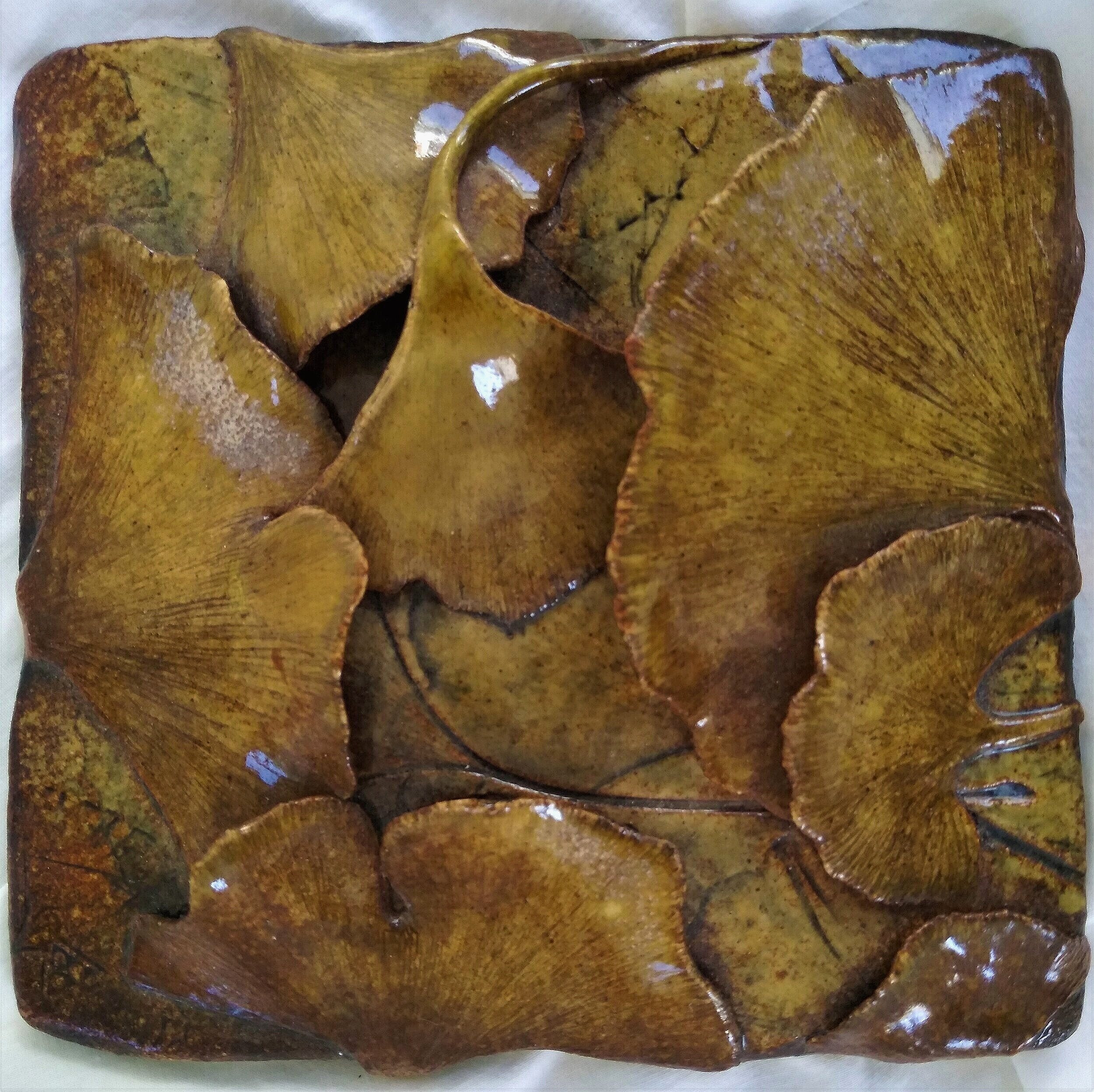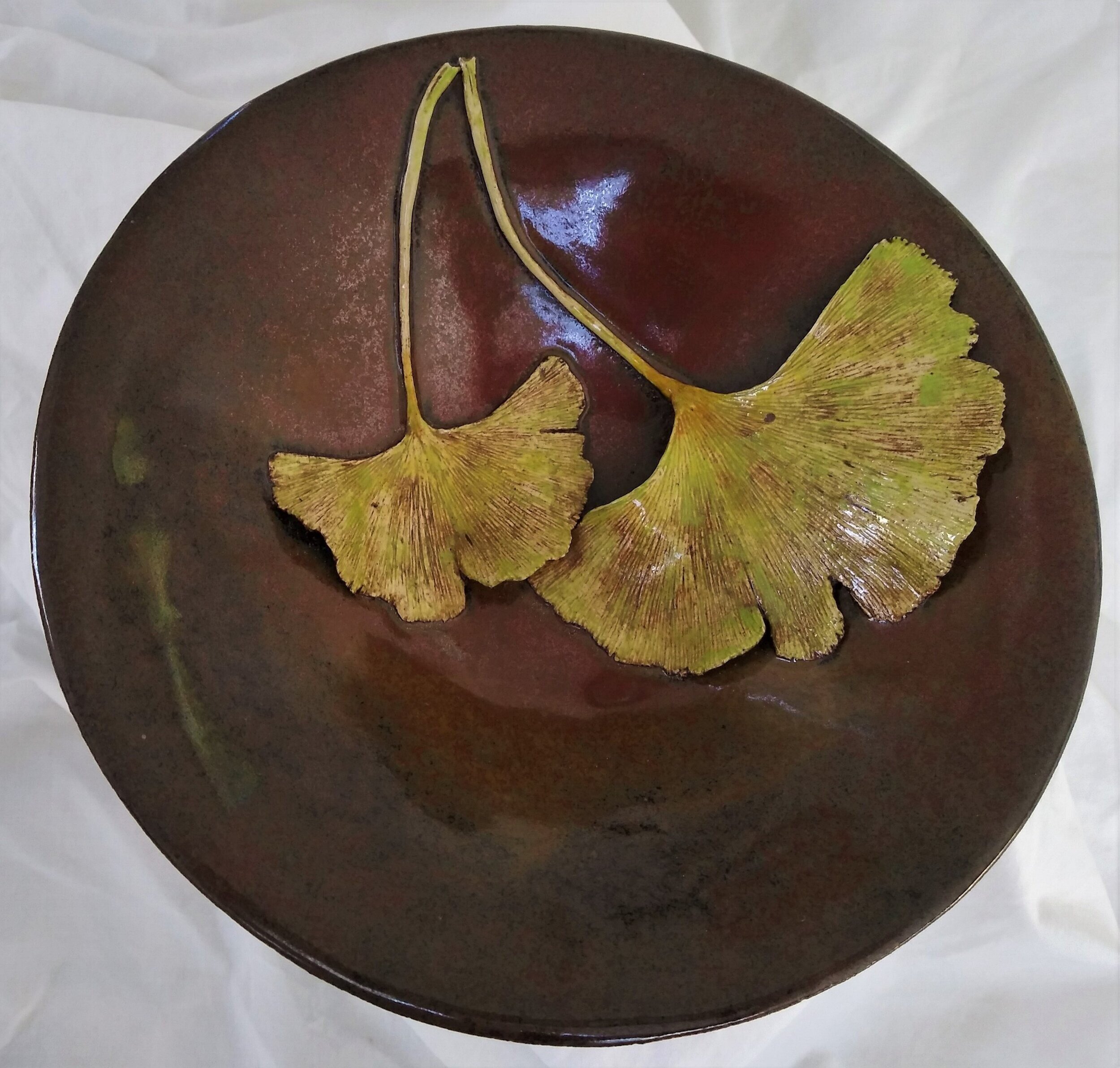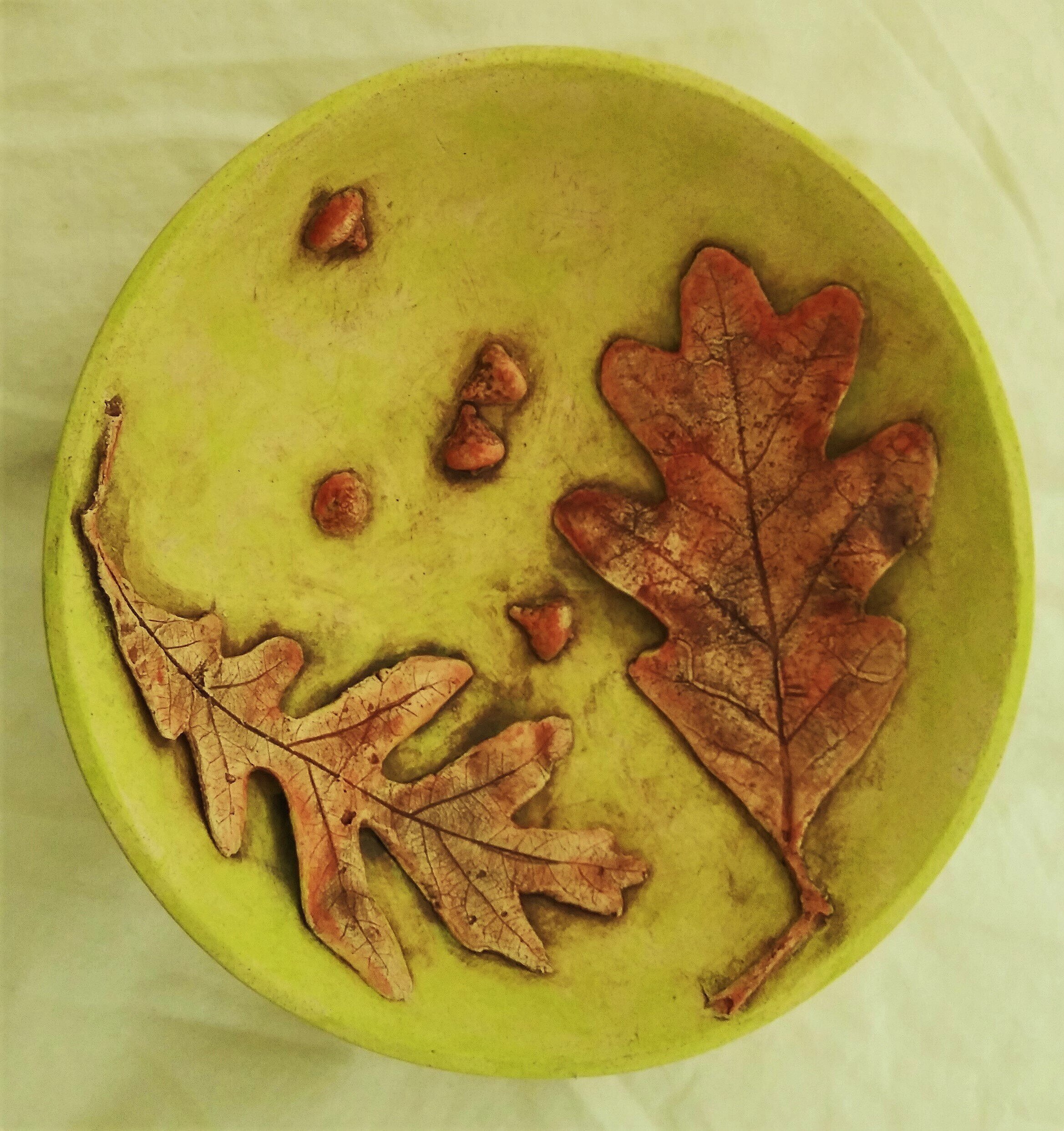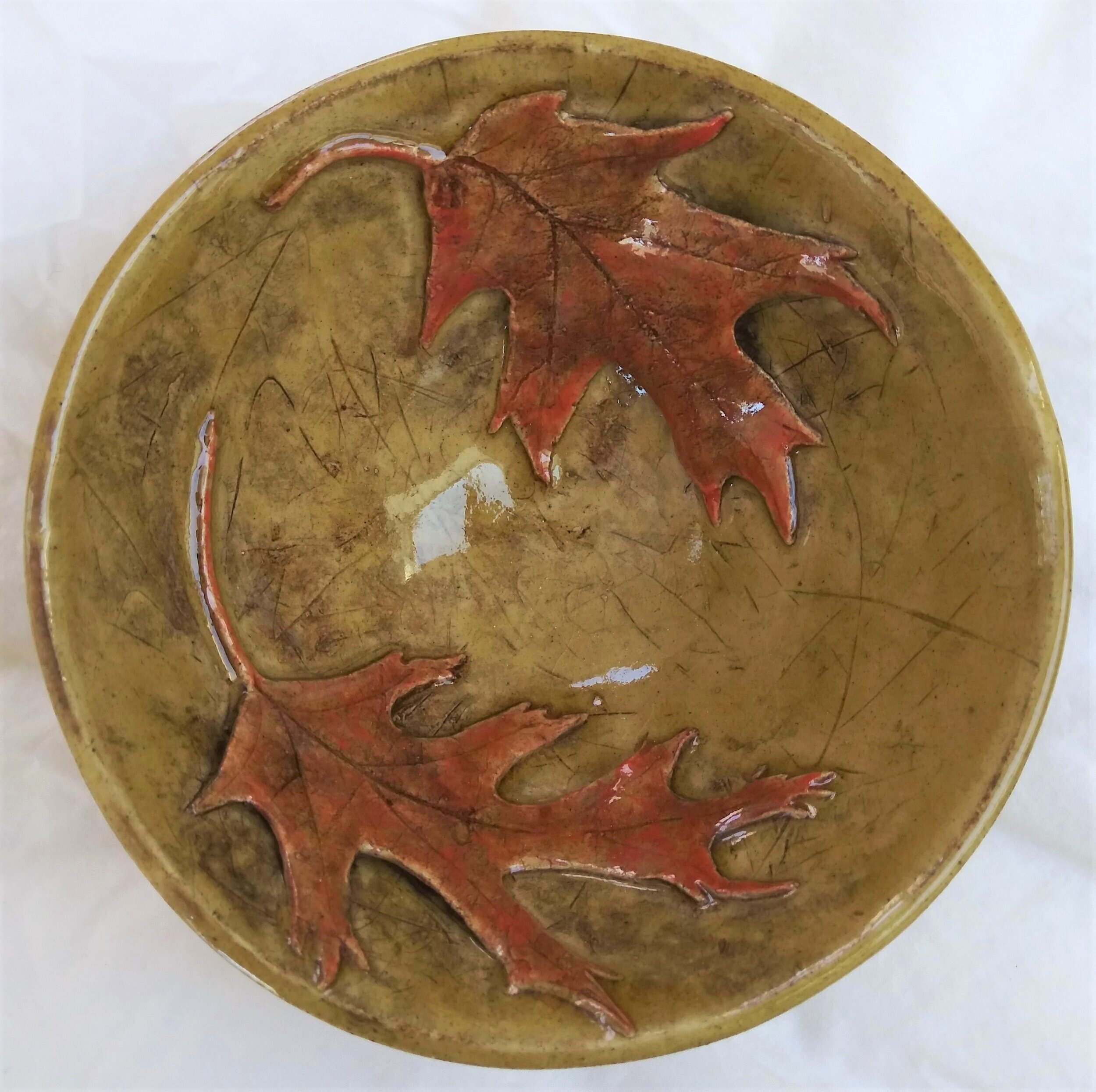
Three Stylized Oak Leaves
This tranquil bowl is home to three stylized oak leaves on shades of ochre and coral.
![Oak Leaves Tile - Verdigris [Artist's Collection - Not for Sale]]](https://images.squarespace-cdn.com/content/v1/5d39faad0c4c2d00019f49a1/1564258575829-ZS3I3IZDQBW2UR3BMH5Q/%2325+-+Oak+Leaves-Verdigris.jpg)
Oak Leaves Tile - Verdigris [Artist's Collection - Not for Sale]]
A pattern of overlapping oak leaves is rendered on this tile in shades of verdigris with copper and iron undertones.
![Twin Ginkgos (1) [SOLD]](https://images.squarespace-cdn.com/content/v1/5d39faad0c4c2d00019f49a1/1564252111051-YYILXWBBZSAL78TYFIKT/%2312+Twin+Ginkgos.jpg)
Twin Ginkgos (1) [SOLD]
In a space free of all distractions, two ginkgo leaves gently rest. The twin leaves have been left with only their under-glaze colors (no clear glaze was added) in order to provide contrast to the shinier background glazes in rich tones of deep red, rust, and charcoal.
![Four Oaks & Eight Acorns (1) [SOLD]](https://images.squarespace-cdn.com/content/v1/5d39faad0c4c2d00019f49a1/1570286202274-8X21ZREI6Q1A865U2GU6/Four+Oaks+%26+Eight+Acorns+1.1.jpg)
Four Oaks & Eight Acorns (1) [SOLD]
The dark glaze used on this bowl “reads” as near-black, but has tones of dark red-brown, ochre and blue. The deep colors provide a dramatic backdrop for the yellow-green, orange and coral tones of the oak leaves and acorns. A unique ring of eight additional acorns forms the base or “foot” of this graceful bowl.

Frost 1 - Six Oak Leaves
Tones of oranges, coral, brown and rose grace the six high-relief white oak leaves that have fallen onto a “cold” forest floor, suggestive of an oncoming frost.
![Ginkgo Cluster Tile (1) [SOLD]](https://images.squarespace-cdn.com/content/v1/5d39faad0c4c2d00019f49a1/1564258576062-HL2MWS06A4XG94R6JA6J/%2326+-+Ginkgo+Cluster.JPG)
Ginkgo Cluster Tile (1) [SOLD]
This tile is rendered in extreme high relief on an incised background. The ginkgo leaves, with their graceful forms, are colored in shades of green. Some are bathed in a creamy white suggesting that winter’s cold has entrapped them on the forest floor.
![Five White Oak Leaves on Yellow [SOLD]](https://images.squarespace-cdn.com/content/v1/5d39faad0c4c2d00019f49a1/1564252108299-CBRNE4LVK7TWNWJZVYR1/%2313+-+5+White+Oak+Leaves+on+Yellow.jpg)
Five White Oak Leaves on Yellow [SOLD]
A nearly-translucent yellow ground, speckled with nickel oxide, is graced by five white oak leaves in vibrant shades of coral and mahogany.
![Pin Oak Leaves & Acorns (6) [SOLD]](https://images.squarespace-cdn.com/content/v1/5d39faad0c4c2d00019f49a1/1564252120695-MO3XOXFDNH3043JTY8HT/%2314+-+Pin+Oak+Leaves+%26+Acorns+%236.jpg)
Pin Oak Leaves & Acorns (6) [SOLD]
Two pin oak leaves and several acorns adorn this bowl. The dark base glaze is punctuated by soft white areas that represent frost.
![Four Ginkgos on Verdigris (1) [SOLD]](https://images.squarespace-cdn.com/content/v1/5d39faad0c4c2d00019f49a1/1568295164701-W057Y48UCB85VYKLMCC0/Four+Ginkgos+on+Verdigris+1.9.jpg)
Four Ginkgos on Verdigris (1) [SOLD]
Four graceful ginkgo leaves seem to have been swirled by the wind before settling into this bowl of light and dark verdigris tones. The matte glaze on the surface provides a contrast for the shiny, high-relief ginkgo leaves.

Three Stylized Oak Leaves 2
The raised veins on these three white oak leaves capture the strength of underlying form that is usually so subtle in oak leaves. On a ground of blues, light golden-green and soft white accents.

Pin Oaks Tile - Autumn (1)
Fallen pin oak leaves in high relief intertwine on the forest floor. The leaves on this tile have a coral or greenish overtone against an incised background of deep golden-green.

Ginkgo Cluster (2)
A multitude of ginkgo leaves swirl and intertwine. This tile is rendered in extremely high-relief, with the most pronounced leaf measuring almost 1/2-inch from the base of the surface.

Twin Ginkgos (2)
In a space free of all distractions, two ginkgo leaves gently rest. The twin leaves—one larger, the other smaller—gracefully arch into the center of the bowl. Background glazes are in rich tones of rust and charcoal, along with other undertones.

Six Oaks with Acorn Base (1)
This vessel contains six oak leaves and several clusters of acorns in high relief. The leaves barely float on the surface—and, indeed, some are so delicate and fragile that the bowl is recommended for decorative use only. A ring of acorns forms the base.

Pin Oaks Tile - Autumn (2)
Fallen pin oak leaves in high relief intertwine on the forest floor. The leaves on this tile have a greenish overtone against an incised background of deep golden-green and coral-red.

Horse Chestnut (1)
The pointy spines of the horse chestnut rise out from the shell’s surface. The background is textured to accentuate the thorniness of the motif. The green chestnut hull is split, exposing the bitter nut case beneath. This is a very “tactile” tile!

Twin White Oaks & Five Tiny Acorns (1)
Two white oak leaves and five tiny acorns adorn this citron-chartreuse bowl. The colors are all rendered in underglaze only (no shiny/glassy glazes were applied).

Red Oak-Frost (1)
A single low-relief oak leaf lies in a shallow of melting snow. Bits of “frost” punctuate the ground.

Twin Red Oaks-Incised (1)
Two red oak leaves in high relief are nestled inside this tiny bowl. A pattern of incised leaf forms add depth and interest to the surface.

Twin Pin Oaks & Acorns Tile (1)
Twin oak leaves, twin acorns (plus a third) are strewn upon the autumnal forest floor, among incised traces of other debris. Nickel oxide spatters mimic the spots so often seen on fading leaves as winter approaches. The tile is press-molded and hand colored with a combination of underglazes and glazes, along with nickel oxide.

Ginkgo High-Relief Tile (3)
This piece is a celebration of the grace and movement of Ginkgo leaves. The near-absence of color invites the study of form alone. Executed in extreme high-relief, the tile is free-formed and employs a combination of underglaze and glazes.

![Oak Leaves Tile - Verdigris [Artist's Collection - Not for Sale]]](https://images.squarespace-cdn.com/content/v1/5d39faad0c4c2d00019f49a1/1564258575829-ZS3I3IZDQBW2UR3BMH5Q/%2325+-+Oak+Leaves-Verdigris.jpg)
![Twin Ginkgos (1) [SOLD]](https://images.squarespace-cdn.com/content/v1/5d39faad0c4c2d00019f49a1/1564252111051-YYILXWBBZSAL78TYFIKT/%2312+Twin+Ginkgos.jpg)
![Four Oaks & Eight Acorns (1) [SOLD]](https://images.squarespace-cdn.com/content/v1/5d39faad0c4c2d00019f49a1/1570286202274-8X21ZREI6Q1A865U2GU6/Four+Oaks+%26+Eight+Acorns+1.1.jpg)

![Ginkgo Cluster Tile (1) [SOLD]](https://images.squarespace-cdn.com/content/v1/5d39faad0c4c2d00019f49a1/1564258576062-HL2MWS06A4XG94R6JA6J/%2326+-+Ginkgo+Cluster.JPG)
![Five White Oak Leaves on Yellow [SOLD]](https://images.squarespace-cdn.com/content/v1/5d39faad0c4c2d00019f49a1/1564252108299-CBRNE4LVK7TWNWJZVYR1/%2313+-+5+White+Oak+Leaves+on+Yellow.jpg)
![Pin Oak Leaves & Acorns (6) [SOLD]](https://images.squarespace-cdn.com/content/v1/5d39faad0c4c2d00019f49a1/1564252120695-MO3XOXFDNH3043JTY8HT/%2314+-+Pin+Oak+Leaves+%26+Acorns+%236.jpg)
![Four Ginkgos on Verdigris (1) [SOLD]](https://images.squarespace-cdn.com/content/v1/5d39faad0c4c2d00019f49a1/1568295164701-W057Y48UCB85VYKLMCC0/Four+Ginkgos+on+Verdigris+1.9.jpg)












